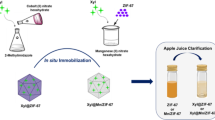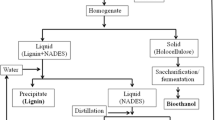Abstract
As the second abundant natural carbohydrate, xylan is normally prepared through alkaline extraction and then used for xylo-oligosaccharides (XOS) production. However, the extracted xylan inevitably contains salt, ethanol, and pigment. In order to investigate the effects of these impurities on XOS production, the alkaline-extracted xylan with different kinds and concentrations of impurities was made and then hydrolyzed using alkaline xylanase (EC 3.2.1.8) to produce XOS. The results showed that a certain concentration of salt (NaCl) promoted the XOS production, while ethanol and pigment inhibited the enzymatic hydrolysis process significantly. The color value mainly ascribed to the phenolic compounds binding to xylan was a key restriction factor in the enzymatic hydrolysis later stage. Using optimal xylan sample (with 10 mg/mL NaCl, color value of 4.6 × 105, without ethanol) as substrate, the highest XOS yield of 58.58 % was obtained. As the substrate of XOS production, prepared xylan should contain colored materials and ethanol as less as possible, however, retains appropriate salt.







Similar content being viewed by others
References
Bailey, M. J., Biely, P., & Poutanen, K. (1992). Interlaboratory testing of methods for assay of xylanase activity. Journal of Biotechnology, 23, 257–270.
Bankova, E., & Bakalova, N. (2014). Enzymatic synthesis of oligosaccharides and alkylglycosides in water-organic media via transglycosylation of lactose. Biotechnology and Biotechnological Equipment, 20, 114–119.
Barendse, R. C. M., Harz, H.-P., & Betz, R. J. (1998). Enzyme preparations stabilized with inorganic salts. US: Gist-Brocades, B.V.
de Moura, F. A., Macagnan, F. T., & da Silva, L. P. (2015). Oligosaccharide production by hydrolysis of polysaccharides: a review. International Journal of Food Science and Technology, 50, 275–281.
Deshpande, M. V. (1992). Ethanol production from cellulose by coupled saccharification/fermentation using Saccharomyces cerevisiae and cellulase complex from Sclerotiun rolfsii UV-8 mutant. Applied Biochemistry and Biotechnology, 36, 227–234.
Dongen, F. E. M. V., Eylen, D. V., & Kabel, M. A. (2011). Characterization of substituents in xylans from corn cobs and stover. Carbohydrate Polymers, 86, 722–731.
Doukyu, N., & Ogino, H. (2010). Organic solvent-tolerant enzymes. Biochemical Engineering Journal, 48, 270–282.
Hong, F., & Yu, S. (2005). Production of xylo-oligosaccharides from corncob xylan by selective hydrolysis with Trichoerma Reesei xylanase. Chemistry and Industry of Forest Products, 2005, 77–81.
Hu, F., & Ragauskas, A. (2012). Pretreatment and lignocellulosic chemistry. Bioenergy Research, 5, 1043–1066.
Jayapal, N., Samanta, A., Kolte, A. P., Senani, S., Sridhar, M., Suresh, K., & Sampath, K. (2013). Value addition to sugarcane bagasse: xylan extraction and its process optimization for xylooligosaccharides production. Industrial Crop Production, 42, 14–24.
Katapodis, P., Nerinckx, W., Claeyssens, M., & Christakopoulos, P. (2006). Purification and characterization of a thermostable intracellular β-xylosidase from the thermophilic fungus Sporotrichum thermophile. Process Biochemistry, 41, 2402–2409.
Kumar, P., Barrett, D. M., Delwiche, M. J., & Stroeve, P. (2009). Methods for pretreatment of lignocellulosic biomass for efficient hydrolysis and biofuel production. Industrial and Engineering Chemistry Research, 48, 3713–3729.
Li, H. Q., & Jian, X. (2013). A new correction method for determination on carbohydrates in lignocellulosic biomass. Bioresource Technology, 138, 373–376.
Lin, Y.-S., Tseng, M.-J., & Lee, W.-C. (2011). Production of xylooligosaccharides using immobilized endo-xylanase of Bacillus halodurans. Process Biochemistry, 46, 2117–2121.
Maalej-Achouri, I., Guerfali, M., Gargouri, A., & Belghith, H. (2009). Production of xylo-oligosaccharides from agro-industrial residues using immobilized Talaromyces thermophilus xylanase. Journal of Molecular Catalysis B: Enzymatic, 59, 145–152.
Maillard, L. (1912). Action of amino acids on sugars. Formation of melanoidins in a methodical way. Comptes Rendus. Académie des Sciences, 154, 66–68.
Panbangred, W., Shinmyo, A., Kinoshita, S., & Okada, H. (1983). Purification and properties of endoxylanase produced by Bacillus pumilus. Agricultural and Biological Chemistry, 47, 957–963.
Panthapulakkal, S., Kirk, D., & Sain, M. (2015) Alkaline extraction of xylan from wood using microwave and conventional heating. Journal of Applied Polymer Science, 132. doi:10.1002/APP.41330.
Purich, D. L. (2010). Enzyme kinetics: catalysis and control: a reference of theory and best-practice methods (1st ed.). Amsterdam: Elsevier.
Saake, B., Kathofer, D., Kruse, T., & Puls, J. (2001). Determination of factors controlling xylan solubility and association. ACS, 221, U189.
Samanta, A., Jayapal, N., Kolte, A., Senani, S., Sridhar, M., Dhali, A., Suresh, K., Jayaram, C., & Prasad, C. (2014). Process for enzymatic production of xylooligosaccharides from the xylan of corn cobs. Journal of Food Processing & Preservation, 39, 729–736.
Samanta, A. K., Jayapal, N., Kolte, A. P., Senani, S., Sridhar, M., Dhali, A., Suresh, K. P., Jayaram, C., & Prasad, C. S. (2015). Process for enzymatic production of xylooligosaccharides from the xylan of corn cobs. Journal of Food Processing & Preservation, 39, 729–736.
Samanta, A., Jayapal, N., Kolte, A., Senani, S., Sridhar, M., Suresh, K., & Sampath, K. (2012). Enzymatic production of xylooligosaccharides from alkali solubilized xylan of natural grass (Sehima nervosum). Bioresource Technology, 112, 199–205.
Shen, C.-Q. (1994). Sugar taste and flavor chemistry (1st ed.). Guangzhou: South Chian University of Technology Press.
Sjaak, V. L., & Koppejan, J. (2008). Handbook of biomass combustion and co-firing. Washington, DC: Earthsacn.
Vagi, E., Simándi, B., Daood, H., Deak, A., & Sawinsky, J. (2002). Recovery of pigments from Origanum majorana L. by extraction with supercritical carbon dioxide. Journal of Agricultural and Food Chemistry, 50, 2297–2301.
Vazquez, M., Alonso, J., Domınguez, H., & Parajo, J. (2000). Xylooligosaccharides: manufacture and applications. Trends in Food Science & Technology, 11, 387–393.
Vegas, R., Alonso, J. L., Domínguez, H., & Parajó, J. C. (2005). Manufacture and refining of oligosaccharides from industrial solid wastes. Industrial and Engineering Chemistry Research, 44, 614–620.
Winterhalter, C., & Liebl, W. (1995). Two extremely thermostable xylanases of the hyperthermophilic bacterium Thermotoga maritima MSB8. Applied and Environmental Microbiology, 61, 1810–1815.
Xiao, X., Bian, J., Peng, X.-P., Xu, H., Xiao, B., & Sun, R.-C. (2013). Autohydrolysis of bamboo (Dendrocalamus giganteus Munro) culm for the production of xylo-oligosaccharides. Bioresource Technology, 138, 63–70.
Xu, Y., & Chen, M. (2002). Study on enzymatic hydrolysis of xylan into xylo-oligosaccharide. Forest, Chemistry and Industry, 22, 57–60.
Yang, R., & Xu, S. (2001). The enzymatic hydrolysis of alkaline extraction xylan. Food Industry Technology, 22, 15–18.
Yao, D., Ping, M. A., Wang, Y., Yang, J., & ZHANG, L.-Y. (2011). Optimization of extraction process for xylan from corncob by response surface methodology. Food Science, 32, 111–115.
Yoshida, M., Liu, Y., Uchida, S., Kawarada, K., Ukagami, Y., Ichinose, H., Kaneko, S., & Fukuda, K. (2008). Effects of cellulose crystallinity, hemicellulose, and lignin on the enzymatic hydrolysis of Miscanthus sinensis to monosaccharides. Bioscience Biotechnology and Biochemistry, 72, 805–810.
Zhao, H. (2005). Effect of ions and other compatible solutes on enzyme activity, and its implication for biocatalysis using ionic liquids. Journal of Molecular Catalysis B: Enzymatic, 37, 16–25.
Zhou, C., Wu, X., & He, B. (2010). Development of glycosidase biocatalysis in non-aqueous phase. Chemical, Industrial and Engineering Program, 29, 1292–1299.
Zhu, Z.-Y., Zhao, L., Ge, X.-R., Tang, Y.-L., Chen, L.-J., Pang, W., & Zhang, Y. (2015). Preparation, characterization and bioactivity of xylobiose and xylotriose from corncob xylan by xylanase. European Food Research and Technology, 241, 27–35.
Acknowledgments
This work was supported by the following foundations: National Natural Science Foundation of China (No. 21276259) and NSFC international (regional) cooperation and exchange project: the International Fund for Young Scientists (No. 21450110062).
Author information
Authors and Affiliations
Corresponding author
Additional information
Rui Shen and Hong-Qiang Li contributed equally to this work.
Rights and permissions
About this article
Cite this article
Shen, R., Li, HQ., Zhang, J. et al. Effects of Impurities in Alkali-Extracted Xylan on Its Enzymatic Hydrolysis to Produce Xylo-Oligosaccharides. Appl Biochem Biotechnol 179, 740–752 (2016). https://doi.org/10.1007/s12010-016-2028-5
Received:
Accepted:
Published:
Issue Date:
DOI: https://doi.org/10.1007/s12010-016-2028-5




